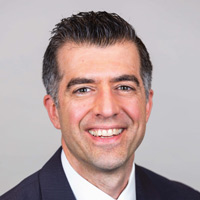Caught in the Middle: How Young Parents Can Plan for Long-term Care
One family’s story shows how important long-term care plans are … and how whole life insurance with a long-term care rider can help.


When my client Heather called, I knew something was wrong. Usually upbeat, this time her voice trembled. She told me her father had a stroke. He was unable to talk, unable to think clearly, and unable to get around like he did before. Heather knew the roles were now reversed; she was the one who would care for her father now. Unfortunately for Heather and her husband Tom, who are in their mid-40s, working full-time and parents of three little girls, there was no way they could do it all on their own. They needed to find someone to help.
Heather’s father had little money, living only on Social Security. Medicare does not cover long-term care for more than 100 days, and they couldn’t afford to pay someone themselves. Medicaid was the only option. After several months of back and forth with government officials, Tom and Heather eventually got her father approved for Medicaid. But this was only the start.
In their search for his new home, they were soon disheartened to learn their choice of long-term care facilities was limited because he was a Medicaid paying patient. The facility manager said they did not have any more Medicaid beds available. Unfortunately, this happens. Their second choice was also full. Much to their chagrin, the only facility available to their likening was 63.5 miles away. They had to do it. They could not afford the cost on their own and they had to take what Medicaid gave them.
From just $107.88 $24.99 for Kiplinger Personal Finance
Become a smarter, better informed investor. Subscribe from just $107.88 $24.99, plus get up to 4 Special Issues

Sign up for Kiplinger’s Free Newsletters
Profit and prosper with the best of expert advice on investing, taxes, retirement, personal finance and more - straight to your e-mail.
Profit and prosper with the best of expert advice - straight to your e-mail.
Fortunately, Heather’s father is doing better. Later, I asked Heather what she learned from all of this. Without hesitation, she said it made her think about her own future. She said she wanted to make plans now and didn’t want to “rely on the government for her own long-term care.” She also did not want to be dependent on her kids for help. She asked for some suggestions.
How to plan for long-term care
Heather and I went through several long-term care planning ideas. (For a deeper look at the options, please read How to Afford Long-Term Care.) Heather is young and healthy, which gives her more options than those who are older or whose health has deteriorated. We discussed self-insuring — saving money in a Health Savings Account and/or a designated stock portfolio for future long-term care expenses. She liked that idea.
We also explored long-term care insurance. Traditional long-term care insurance, where you pay per year, wasn’t a good fit because she was nervous the company could raise the premiums over time. That is a legitimate concern, especially for someone who is younger, like Heather. Over her lifetime she could see premium rate increases by the time she needs the coverage later on in life.
Life and long-term care insurance option
Knowing Heather had a young family and a mortgage, I asked Heather what she thought if we could combine the benefits of life insurance with long-term care insurance? I explained how whole life insurance is the Swiss Army knife of financial planning tools — able to accomplish multiple objectives in one product. Foremost, whole life provides long-term life insurance protection for her and the family. There is also a cash value account where part of her premium is invested by the insurance company and can grow.
But the real kicker is the long-term care rider. For a fraction of the cost of the annual premium, the long-term care rider allows the policy owner to accelerate the payment of a portion of their policy death benefit to pay for covered long-term care services. The rider provides long-term care coverage for both home and facility care.
Benefits of a whole life policy with a long-term care rider
Heather and Tom liked the idea of combining life insurance and long-term care in one product. The whole life provides long-term death protection for their young family and a conservative savings account if they need it.
But equally important, the long-term care rider hit home for them. The rider provides a reliable source of funds for long-term care expenses, regardless of stock or bond market fluctuations. The long-term care rider also gives them more flexibility then Medicaid when choosing a facility.
What to consider before you buy
I explained to Heather and Tom the tradeoffs. Whole life insurance premiums need to be paid each year. For this reason, ensure you can afford the premium. Also, shop it around. If you use an insurance agent of one company, you may be limiting your options. I usually spreadsheet several carriers to compare the cost. I also recommend sticking with a highly rated carrier. All insurance companies are rated for their financial strength and claims paying ability. I suggest sticking with an A+ insurance company. You can usually see an insurer’s rating on their website. Finally, ask your agent how the long-term care rider works. Indemnity riders pay the full long-term care benefit monthly. Reimbursement long-term care riders pay actual expenses incurred. There are pros and cons to both.
The takeaway: Start the long-term care conversation now
Stories like Heather and Tom’s are not uncommon. They are in the sandwich generation — middle-age parents caring for their kids and their parents. This puts a tremendous strain, emotionally and financially, on young families. However, there is a silver lining. In helping her father navigate his long-term care, Heather got motivated to plan for her own future. While Heather and Tom are younger, healthy and working, they have more options and more time on their side to plan for long-term care.
For young parents, long-term care may seem like a long way off, and probably a lower priority given these troubling times we are in. However, if you have young children, you know time goes by fast. My suggestion for young families, consider looking at whole life insurance with a long-term care rider to accomplish multiple objectives in one product. We all have limited dollars, and multiple financial goals. We need to be smart about divvying up the pie.
Investment advisory and financial planning services are offered through Summit Financial LLC, an SEC Registered Investment Adviser, 4 Campus Drive, Parsippany, NJ 07054. Tel. 973-285-3600 Fax. 973-285-3666. This material is for your information and guidance and is not intended as legal or tax advice. Clients should make all decisions regarding the tax and legal implications of their investments and plans after consulting with their independent tax or legal advisers. Individual investor portfolios must be constructed based on the individual’s financial resources, investment goals, risk tolerance, investment time horizon, tax situation and other relevant factors. Past performance is not a guarantee of future results. The views and opinions expressed in this article are solely those of the author and should not be attributed to Summit Financial LLC. Links to third-party websites are provided for your convenience and informational purposes only. Summit is not responsible for the information contained on third-party websites. The Summit financial planning design team admitted attorneys and/or CPAs, who act exclusively in a non-representative capacity with respect to Summit’s clients. Neither they nor Summit provide tax or legal advice to clients. Any tax statements contained herein were not intended or written to be used, and cannot be used, for the purpose of avoiding U.S. federal, state or local taxes.
Profit and prosper with the best of Kiplinger's advice on investing, taxes, retirement, personal finance and much more. Delivered daily. Enter your email in the box and click Sign Me Up.

Michael Aloi is a CERTIFIED FINANCIAL PLANNER™ Practitioner and Accredited Wealth Management Advisor℠ with Summit Financial, LLC. With 21 years of experience, Michael specializes in working with executives, professionals and retirees. Since he joined Summit Financial, LLC, Michael has built a process that emphasizes the integration of various facets of financial planning. Supported by a team of in-house estate and income tax specialists, Michael offers his clients coordinated solutions to scattered problems.
-
 Dow Adds 646 Points, Hits New Highs: Stock Market Today
Dow Adds 646 Points, Hits New Highs: Stock Market TodayIt was "boom" for the Dow but "bust" for the Nasdaq following a December Fed meeting that was less hawkish than expected.
-
 5 Types of Gifts the IRS Won’t Tax: Even If They’re Big
5 Types of Gifts the IRS Won’t Tax: Even If They’re BigGift Tax Several categories of gifts don’t count toward annual gift tax limits. Here's what you need to know.
-
 The 'Scrooge' Strategy: How to Turn Your Old Junk Into a Tax Deduction
The 'Scrooge' Strategy: How to Turn Your Old Junk Into a Tax DeductionTax Deductions We break down the IRS rules for non-cash charitable contributions. Plus, here's a handy checklist before you donate to charity this year.
-
 I'm a Tax Attorney: These Are the Year-End Tax Moves You Can't Afford to Miss
I'm a Tax Attorney: These Are the Year-End Tax Moves You Can't Afford to MissDon't miss out on this prime time to maximize contributions to your retirement accounts, do Roth conversions and capture investment gains.
-
 I'm an Investment Adviser: This Is the Tax Diversification Strategy You Need for Your Retirement Income
I'm an Investment Adviser: This Is the Tax Diversification Strategy You Need for Your Retirement IncomeSpreading savings across three "tax buckets" — pretax, Roth and taxable — can help give retirees the flexibility to control when and how much taxes they pay.
-
 Could an Annuity Be Your Retirement Safety Net? 4 Key Considerations
Could an Annuity Be Your Retirement Safety Net? 4 Key ConsiderationsMore people are considering annuities to achieve tax-deferred growth and guaranteed income, but deciding if they are right for you depends on these key factors.
-
 I'm a Financial Pro: Older Taxpayers Really Won't Want to Miss Out on This Hefty (Temporary) Tax Break
I'm a Financial Pro: Older Taxpayers Really Won't Want to Miss Out on This Hefty (Temporary) Tax BreakIf you're age 65 or older, you can claim a "bonus" tax deduction of up to $6,000 through 2028 that can be stacked on top of other deductions.
-
 Meet the World's Unluckiest — Not to Mention Entitled — Porch Pirate
Meet the World's Unluckiest — Not to Mention Entitled — Porch PirateThis teen swiped a booby-trapped package that showered him with glitter, and then he hurt his wrist while fleeing. This is why no lawyer will represent him.
-
 Smart Business: How Community Engagement Can Help Fuel Growth
Smart Business: How Community Engagement Can Help Fuel GrowthAs a financial professional, you can strengthen your brand while making a difference in your community. See how these pros turned community spirit into growth.
-
 In 2026, the Human Touch Will Be the Differentiator for Financial Advisers
In 2026, the Human Touch Will Be the Differentiator for Financial AdvisersAdvisers who leverage innovative technology to streamline tasks and combat a talent shortage can then prioritize the irreplaceable human touch and empathy.
-
 How Financial Advisers Can Deliver a True Family Office Experience
How Financial Advisers Can Deliver a True Family Office ExperienceThe family office model is no longer just for the ultra-wealthy. Advisory firms will need to ensure they have the talent and the tech to serve their clients.